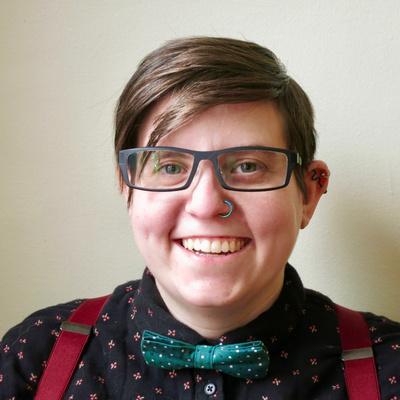Circus Sessions 2018 Makes a Bold Move, Proving that Circus is for Everybody
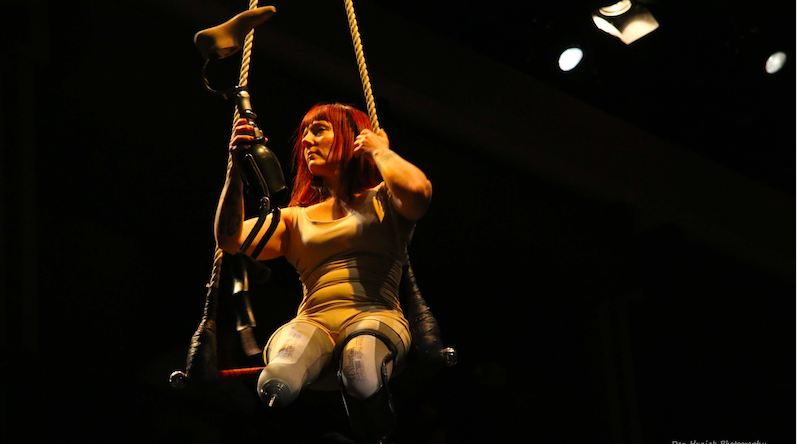
This year’s Circus Sessions, was a bold experiment in accessibility. Produced by Femmes du Feu, where Holly Treddenick is artistic director, at Harbourfront Centre, and led by artist mentor Marie-Andreé Robitaille, this year’s showing covered innovative territory and pushed forward the state of accessible circus showings in Canada.
Circus Sessions is a five-day creative laboratory for circus artists in Canada and beyond to explore, collaborate and experiment, led by a different artist mentor every year. This process culminates in a two-day public showing of experimentation and collaboration. For Circus Sessions, diversity is a key aspect of the mandate, which is an area where contemporary circus often fails. While it is notable that the cast was not entirely white (which frequently occurs in North American contemporary circus) in a city as diverse as Toronto, one might expect to see a broader representation of circus artists of colour. Furthermore, there were multiple members of the cast who identify as chronically ill or disabled, which is rare in a field where high performing circus artists are typically non-disabled.For this year’s fourth season of Circus Sessions, a decision was made to incorporate audio description and other accessibility features for the first time.
The focus on accessibility was the result of a meeting between Alex Bulmer, an actress, and Treddenick during the 2017 production of Circus Sessions. Bulmer, who is blind, was working with Harbourfront Centre on their accessibility mandate, and attended the 2017 production of Circus Sessions, during which a portion of the showing was described by two circus performers in both concrete and abstract terms. For Bulmer and Treddenick, this portion of the showing was the entry way into experimentation with integrated audio description for this year’s showing. Treddenick recounts “Me being naive and not knowing about audio describing, I had the vision of it being done aloud and almost poetic. She (Bulmer) said that it is never done that way and would be a radical new exploration, so of course we both jumped on it.”
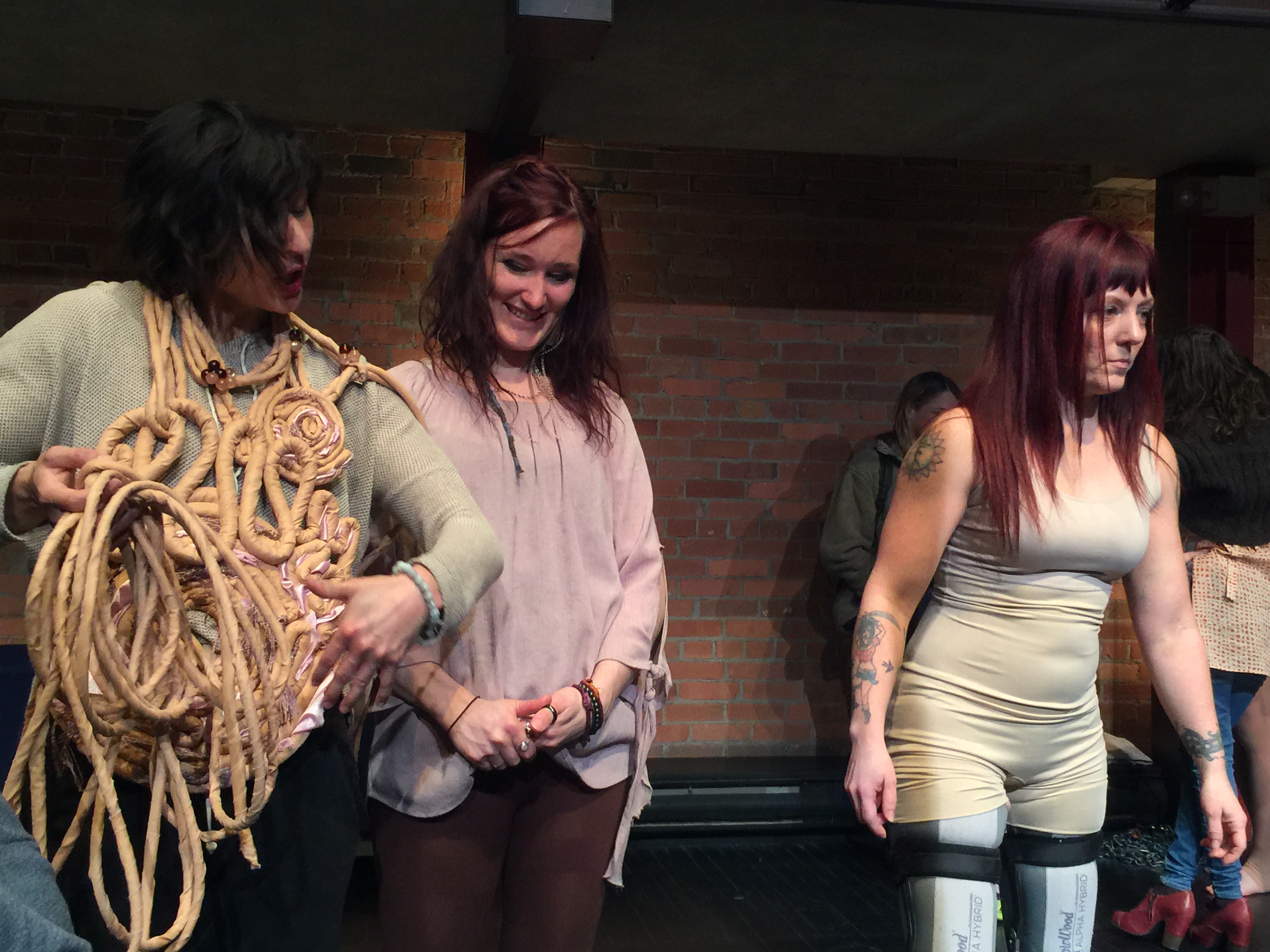
As part of the exploration, an accessibility and audio describing team was recruited for this year’s showing to be led by Bulmer, consisting of Erin Ball, Katharine Kavanagh, and Whitney Treddenick. Each came to the task with a different perspective and level of experience with circus and accessibility. Ball first found circus over ten years ago from a background in personal training and yoga, and was instantly “totally hooked”. After a life-changing incident several years ago, she became an amputee and had to relearn circus all over again. Currently, she is focusing on developing methods for teaching aerial circus to amputees, and has an interest in adapting circus and performance to be more inclusive. Kavanagh has been involved with circus for over ten years, and is the founder of Circus Diaries, a website dedicated to sharing reviews and critical insider information about the circus sector. Kavanagh had developed a keen interest in combining audio description, live notation and circus, and approached Holly directly about participating in this experiment with Circus Sessions. Whitney works with young people and adults who are Deaf-Blind, either due to congenital or acquired causes. The Deaf-Blind individuals that she works with also have additional disabilities. She also has a dance background, and was invited one day to a circus class by Holly (her cousin) and instantly fell in love. She was drawn to this opportunity with Circus Sessions as a way to integrate her passion for circus with her work with Deaf-Blind individuals.
The accessibility team undertook their own experimental process in developing accessibility during the week-long Circus Sessions lab. The team started with gaining a full understanding of what traditional audio describing typically entails. Generally, audio describers are located off stage of a performance, and transmit the audio description of a performance through an earpiece directly into a blind or low-vision patron’s ear. The team quickly began to find ways of “creatively breaking the rules” as Whitney describes. They experimented with various ways of creating a sonic experience of the circus for audio members – using words or visuals to create a similar impact of the performance rather than only providing a description of the visual information audience members may have missed.
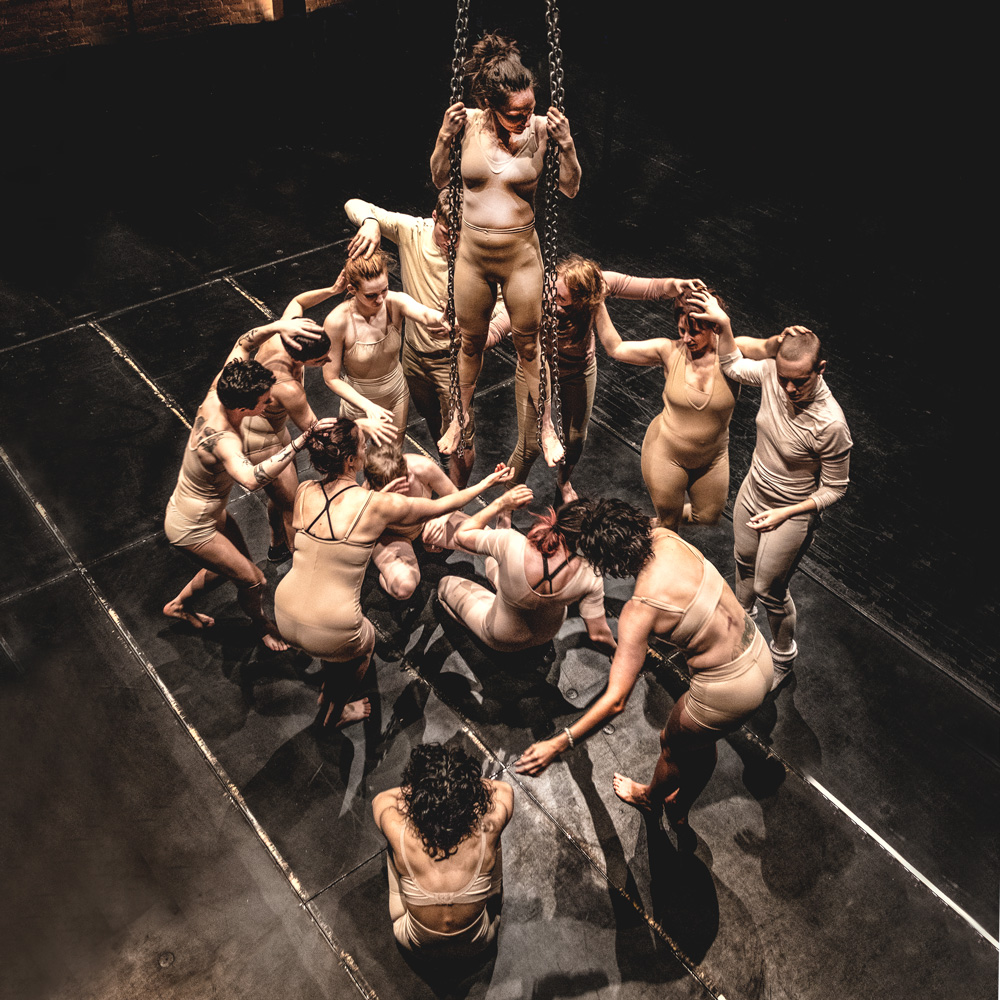
After the week-long creation process, the accessibility team settled on providing a number of accessibility features for this year’s showing: integrated audio description, a tactile model of the performance space, including models of various apparatuses used, a pre-show touch tour of the performance space, words and poetry written in large print on chart paper, and some integration of American Sign Language interpretation (primarily for Holly’s pre-show introduction).
Prior to each showing, the doors opened early for those who wished to participate in a touch tour. Participants were greeted by a stage replica built out of straws, netting and pipecleaners, with bits of silks attached. They were encouraged to touch this replica, and even experience the changing height and interchangeability of the center apparatus. This replica allowed participants to gain an understanding of the space, and begin to develop a mental image of the room they were walking into before they entered the stage. Ball’s legs were one of the items explained to participants, including an introduction to the sound that they make when she walks, so they could place the sound during the show.
Next, participants were led directly onto the showing floor by members of the access team, as the performers were warming up. Participants were led to various apparatuses, such as the Chinese Pole, or balancing canes and were encouraged to touch them. The team also gave a lesson on how the apparatus would be used in the space. Costumes and props the performers will be using are explained, and participants are also welcome to touch them. Some performers were even happy to provide an immersive experience for participants, leading them in a basic lesson of hand hooping, or a quick experience in the aerial hammock. This helped participants gain an understanding of the experience for the performers as well as the audience members. In travelling the space, participants also gained an understanding of how large the stage is, and how much action it could simultaneously support. A few minutes before the house opened to the rest of the audience, the participants were supported in locating seats.
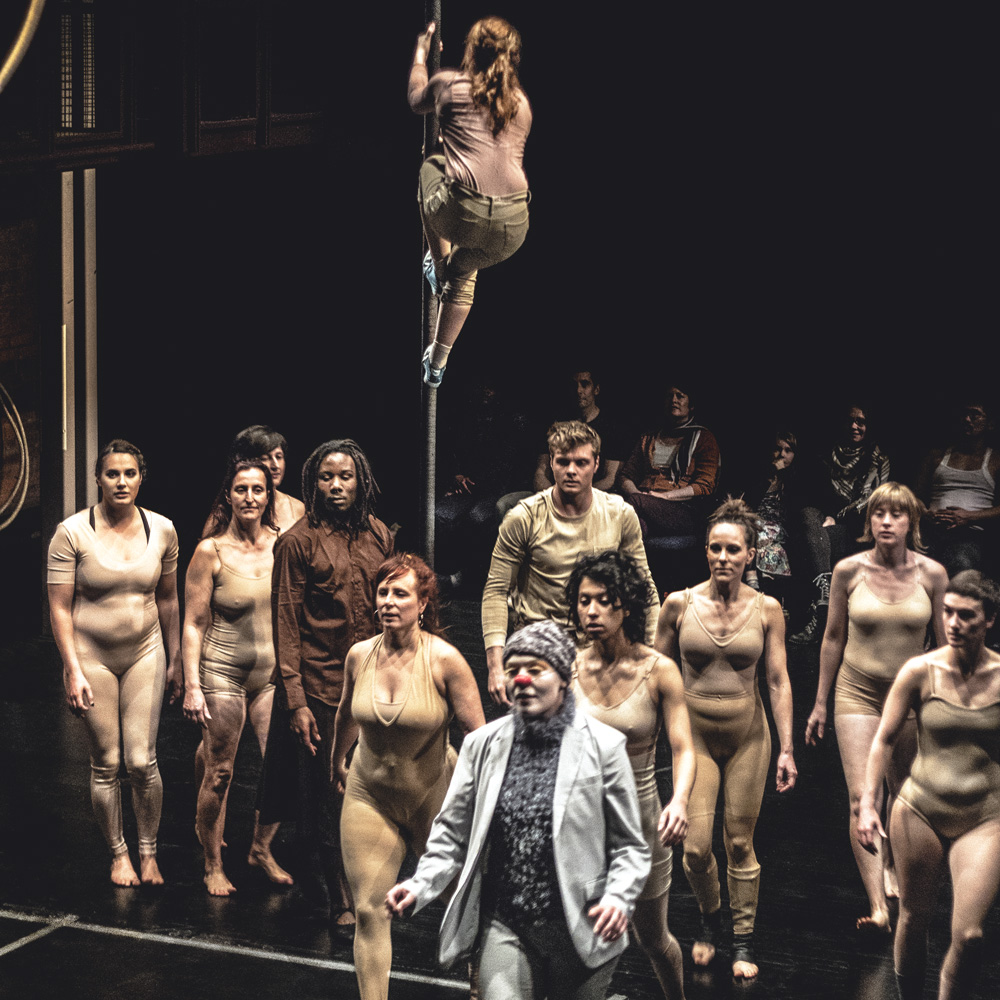
As the performance began, Kavanagh was perched on a balcony above the stage to deliver the audio description. With no other sound in the performance (one element explored this year was the sonic experience of circus, and what sounds tell their own story), the audio description directed both sighted and blind attention alike. In being removed from the performance floor, Kavanagh’s description was somewhat reminiscent of the ring master from a traditional circus.
The accessibility team made a conscious decision to focus on action words, and words that evoke feelings, rather than dispassionately describing the constant movement of the various acrobats. This description was particularly impactful when it is be done in collaboration with performers. Tina Carter, an aerialist from the UK with several years of experience coaching and collaborating with disabled aerialists, began her hammock act by yelling the word “ooooooold”, which the accessibility team jointly signed, signaling the force of Carter’s proclamation. Carter further editorialized her own act “I slide on burning flesh” allowing the entire audience an understanding not only of her movement, but how that movement impacted her own body. It’s an inside view on an experience the audience has potentially never had.

Maggie Karlin’s juggling act was another fantastic example of the creative ways that audio description can unfold. The accessibility team set the stage for Karlin’s act, describing the club and ball that would be juggled, and then handed the responsibility for the description of the act itself to Karlin. Karlin chose to represent each movement of each apparatus with a different noise, creating a sonic experience that paralleled the visual one. For those who are unfamiliar with the ways that patterns influence juggling and object manipulation it was an immersive experience into understanding the complex decisions that go into choosing how to manipulate objects through space in relationship to one’s body.
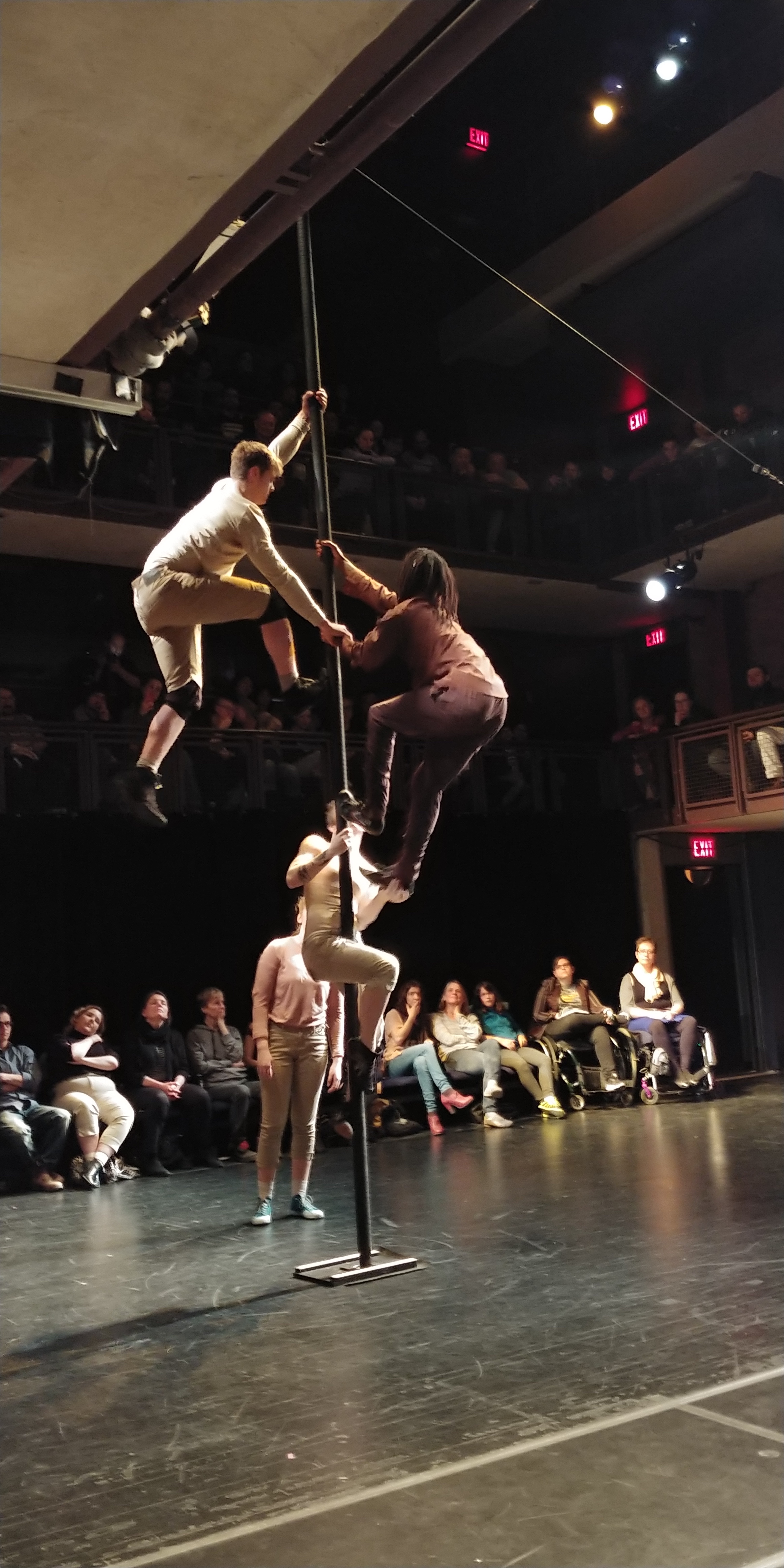
Although the goal of the integrated audio description was not to draw interpretations for the audience, there were moments where sparse descriptions of the movements on stage could have been improved to allow for greater clarity of intent. This is particularly evident during the multi-acrobatic Chinese Pole act involving Karlin, Ida Cramer, Andrei Anissimov, and Natayu Mildenberger. At one point during this act, Mildenberger (a black acrobat) is forcibly moved up the pole by his white colleagues. Shortly afterward, he transports the chains used in the next act to their center location, by holding them around his neck and in his hands. The audio description of these sequences decidedly avoids mentioning Mildenberger’s race, nor what these sequences possibly suggest. When the cast is predominantly white, these moments had particular significance, and perhaps more context should have been provided to assist the audience in recognizing the implications of these moments.
Recognizing that one week is not enough time to create a fully accessible showing, the accessibility team was careful to position their work as an experiment in accessibility. There was a recognition that this experiment is a starting place to build a foundation of accessible circus performances from. The team was quick to offer up many suggestions that others hoping to increase accessibility in their showings can implement. The first suggestion was to recognize that a focus on accessibility needs to happen from the beginning stages of a production, and that frequently the process to make something accessible takes more time than one thinks that it will. Additionally, Kavanagh stressed the importance of involving those with disabilities in the process, to ensure that their needs are being met rather than making assumptions about what those needs might be. When asked about next steps in this process Carter was quick to offer the suggestion that future lead artists could be disabled, which would help reduce current divisions that exist between circus arts and the disability arts world.
Furthermore, accessibility in the circus world should not stop at making performance accessible to disabled audiences, but rather encourage the development of disabled performers. It is vital to recognize that while traditional circus was often developed with disabled people playing an integral role, contemporary circus often erases the role that disabled people played in the path towards circus as we know it today. It is necessary to question this erasure, and ensure that disabled people are not excluded from a discipline that they were pivotal in shaping and creating. The accessibility team offers that when assessing circus spaces on the basis of including disabled circus artists, accessibility within circus environments is about far more than just the physical space, but also about feeling welcome, safe, and understood. Carter recognized that one of the most significant barriers is attitudinal, and that circus spaces must shift to a culture of being welcoming of difference, and the potential and possibility that difference can offer. While attitudinal barriers can be some of the most difficult to address, frequently they can be overcome through education, experience and willingness to have an open mind creatively to imagine positive outcomes for all participants. Ball stated the importance of planning for the people that you hope to be present within a space, and communicating with them to ensure they feel their needs are met. It is crucial that this is the kind of work that circus spaces need to take on to ensure that circus does not continue the erasure of disabled bodies.
Overall, this year’s Circus Sessions brings forward an impressive collaboration on accessibility, which boldly points forward towards a circus future of disabled performers, accessibility teams, and audience members. This is absolutely a circus showing those interested in integrating accessibility features into their performance should take note of. I look forward to seeing further experimentations with accessibility in years to come.
Main image caption: Erin Ball sits on a dance trapeze and holds one prosthetic leg in her right hand, gazing at it after having taken it off of her body. Photo courtesy of Dan HuziakEditor's Note: At StageLync, an international platform for the performing arts, we celebrate the diversity of our writers' backgrounds. We recognize and support their choice to use either American or British English in their articles, respecting their individual preferences and origins. This policy allows us to embrace a wide range of linguistic expressions, enriching our content and reflecting the global nature of our community.
🎧 Join us on the StageLync Podcast for inspiring stories from the world of performing arts! Tune in to hear from the creative minds who bring magic to life, both onstage and behind the scenes. 🎙️ 👉 Listen now!



